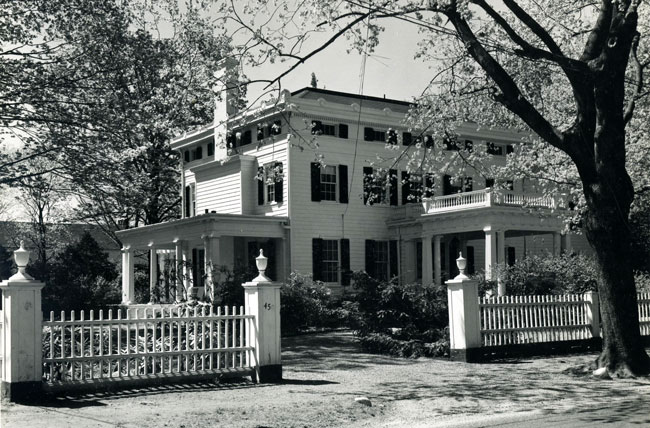
The landmark 1779 Justus Sackett house is still standing in Greenwich, but not in its original setting under a large black walnut tree at the corner of North Street and North Maple Avenue. In 1855 the house was expanded and remodeled, and a half-century later was raised and removed to its present site on Patterson Avenue. It must have been quite a project¸ since by then the elegant house had three full stories and eight bedrooms.
Justus had purchased the land for his estate in 1778 from Nehemiah Mead Jr. for $2,350.The Meads were one of the founding families of Greenwich, with John Mead arriving in Greenwich in 1660, sailing on Captain Stagg’s ship, “Elizabeth.” At his death in 1696, he left eight sons and three daughters. The Meads continued to produce large families, as was the custom at the time, and by 1833 there were 97 Mead residences on the Greenwich tax assessor’s list. Justus would once again buy land from a Mead family member later on.
Back in 1696 John Mead sold the original property to Benjamin Mead, his sixth son, for 200 pounds in “New York” money. Mentioned in the deed were the land, a house, an orchard and woodland. He, in turn, granted the land to his son, Obadiah Mead, in 1746. The land then went to Obadiah’s two daughters Phoebe and Mary.
The supremely elegant Federal mansion is sheathed in white clapboard, with black shutters and classical architectural detail. An elaborate portico at the front entrance has four pairs of columns and is surmounted by a roof gallery.
Inside, an impressive center hall has pillars of limestone and sand. The first floor has 10-foot ceilings throughout and polished narrow-board flooring of oak or maple, usually running front to back with herringbone corners. Fireplaces and accompanying mantels were probably replaced when the house was moved at the turn of the 20th century, and some of the windows date to the mid-19th century.
The house relates to its landscaped surroundings, with wrap-around windows leading to the porch and garden in the dining room. Here, some windows are pegged, and the fireplace has turn of the century bricks. The living room has floor-to-ceiling windows on both sides of the fireplace, leading to a veranda, along with elaborate moldings and trim.
The second-floor ceilings run to eight feet in height, one of the doors is pegged, and the baseboards are an unusually deep nine inches. One bathroom on this level retains a claw-foot tub. The third floor with its notable eyebrow windows probably housed the staff bedrooms in the past, and there’s an attic above.
To the rear of the now one-acre property is detached garaging for three cars that still carries hints of its carriage house past with horse stalls and partially wooded floors. Above is a rentable four-bedroom apartment with an individual entrance.
In his will, Justus, who died in 1827 at the age of 87, left his son Justus, Jr. the ancestral tall clock and his young slave, “Charles.” His wife, Anna Lyon, lived to 96, dying ten years later.
Three generations of the Sackett family lived in the house until 1852, when it was sold first to James Dominick, then John Sniffen, both of whom had homes in New York City.
At one time Sackett also owned Calf Island off the Byram Shore, once camping grounds for town organizations and now part of the Stewart McKinney National Wildlife Refuge, a constellation of islands running for 70 miles along the Connecticut coastline from Greenwich to Westbrook and owned by the federal government. The island of more than 20 acres, was received by John Bonds in 1676 as a grant from Greenwich. Sackett bought the island from Abraham Mead in 1782 for $250, and it was sold to Joseph Brush in 1831 for $610.
During the lengthy 300-year history of the house, there have been a number of noted owners, among them William S. Hirschberg, founder and senior partner of the Greenwich law firm, Hirschberg, Pettengill, Strong & Nagle, later merged with Whitman & Ransom. In the ‘’20s and ‘’30s Hirschberg was a member of the Board of Estimate & Taxation and the school board, now the Board of Education, a judge and a Connecticut state senator. He also, with Charles A. Dana, helped form a foundation in Dana’s name for education and medicine.
The articles were featured in the greenwich.patch.com throughout 2012.

